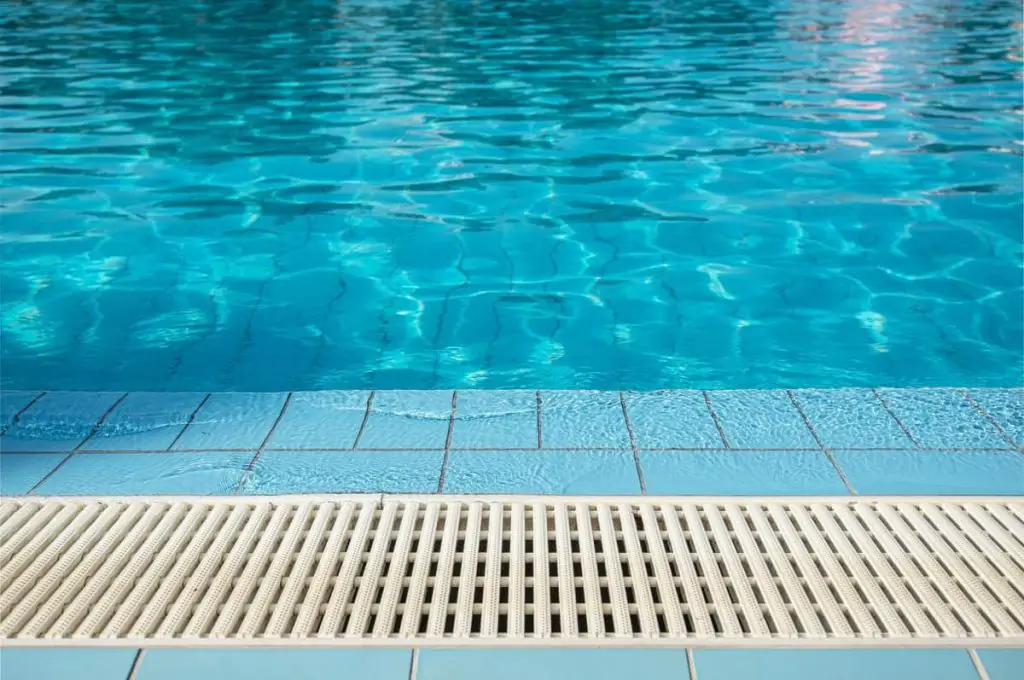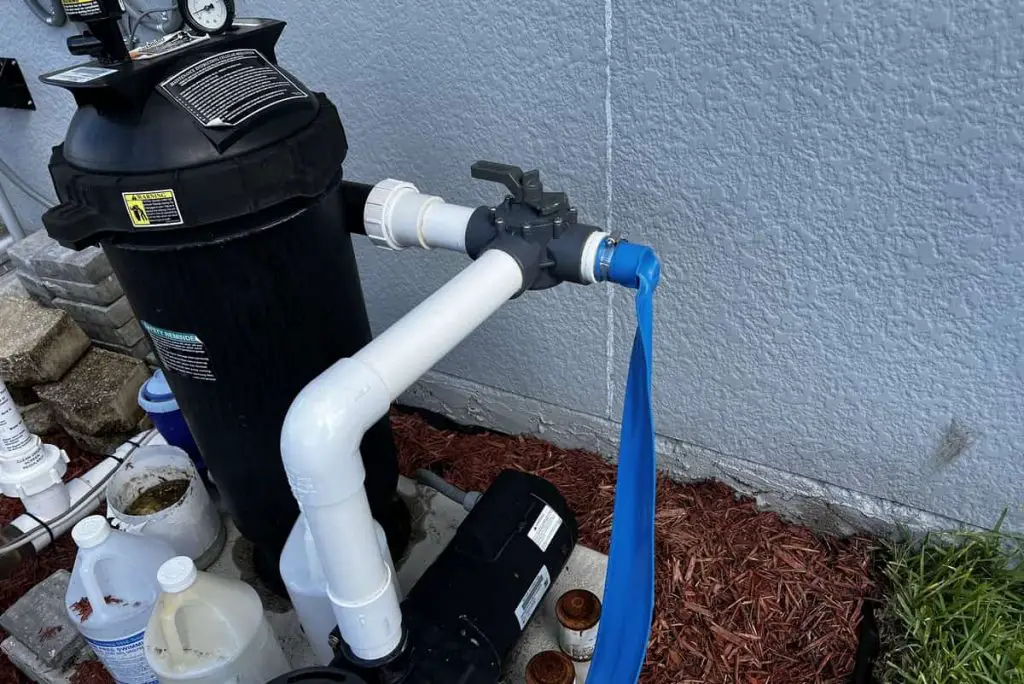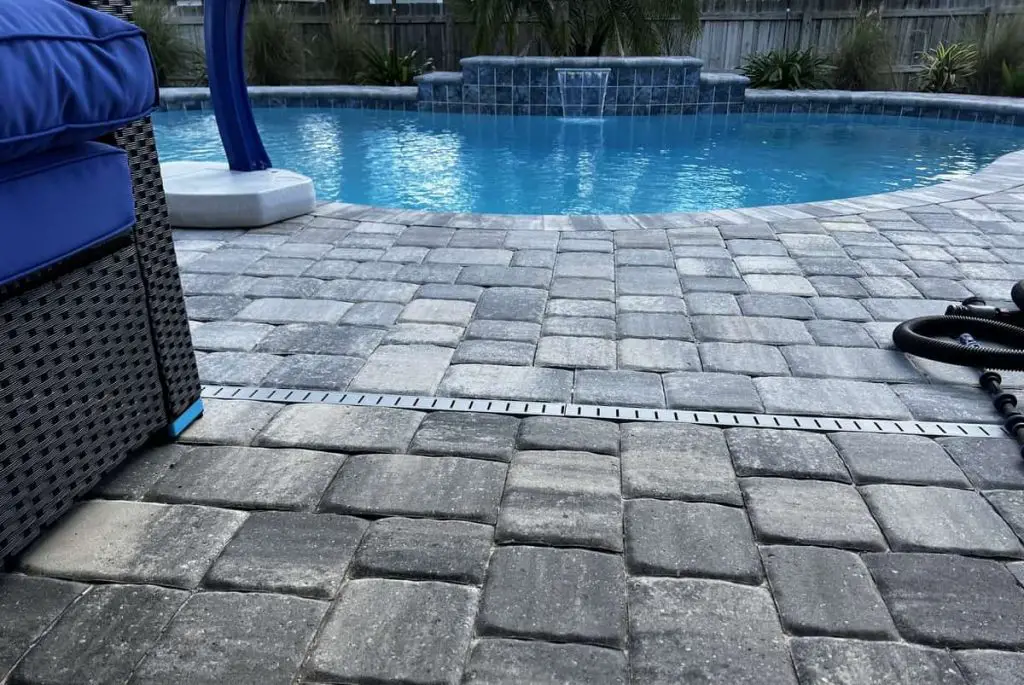It’s rained seemingly nonstop for days straight, and the water levels seem on the verge of overflowing. What do you do when the rain pushes your pool water levels over the waterline? Do swimming pools overflow when it rains?
Swimming pools will overflow with enough rain if no preventive steps have been taken to avoid an overflow. For inground pools with overflow drains, the drains are typically installed within the decking outside of the pool, so overflows will still occur though they may be contained.
In this extensive guide, we’ll talk in detail about what happens when rain causes your pool to overflow, the best ways to respond, and provide tips to prevent overflowing from ever occurring.

Is It Bad for a Pool to Overflow?
Your pool has a waterline you always strive to stay within. Yet when it rains, how much water is in the pool is outside of your control. That doesn’t mean it’s a good idea to ignore what’s going on with your pool, though. When the rain causes swimming pool overflows, it can be bad for several reasons.
Introduces Contaminants into the Water
The rain itself is clean, but it tends to catch particles and pollen that you don’t want in your pool as it falls. Runoff from the nonstop rain is dirty and full of other contaminants that then flow into your swimming pool.
These contaminants will throw off the chemistry of your pool water, forcing you to have to re-chlorinate and use other pool treatments.
Puts Strain on the Pool Equipment
Your pool pump and filter work hard to maintain the cleanliness of your pool. The filter pump takes water from the main drain and the skimmers and then sends it to the filter, which will clean the water. Yet when the water is constantly dirty because it’s full of contaminants, the filter’s work will be nonstop. The pump also doesn’t stop running.
These parts of your pool aren’t designed to be overworked, and the strain degrades their lifespan. If they don’t break during this stretch of rainy weather, then your pump or filter could fail on you later in the season.
Cracks the Pool Deck
When your pool overflows and the excess water has nowhere else to go, it sits on the deck and can seep within. The concrete can then crack or heave. This happens more often if you have an older deck and there’s clay in the soil.
Once it finally stops raining, you can patch up a small crack, but ignoring it will cause the crack to spread to the rest of the deck.
Affects Yard Drainage
Soil erosion is another nasty side-effect of an overflowing swimming pool. Water, especially when flowing in large quantities, can change the shape of the soil in your yard, creating divots, peaks, and valleys where there were none before.
If your yard has a natural slope that allows water to run off while it rains, the slope can erode over time. Now, the water has nowhere to drain, leaving your yard a soggy puddle. Over time, the erosion effects can spread throughout the whole yard.
Might Lead to House Flooding
In the most severe cases, an overflowing pool could cause house leaks. If your yard is flooded because of your overfull swimming pool and the water reaches the foundation, it can drip into the basement. Repairing foundational leaks can be very expensive but necessary.
What Do You Do If Your Pool Overflows When it Rains?
You can see now why standing idly by when your swimming pool overflows is not an option. You have to get on your raincoat and your rainboots and prepare to remediate the issue as best you can.
Here’s how to handle an overflowing pool from rain:
- Siphon or drain the water back to a normal operating level
- Test the pool water chemistry as rain can throw off water balance
- Add pool chemicals needed to bring the water back into balance
The steps mentioned above are pretty simple to perform yourself. However, if you aren’t experienced or confident in your abilities, I’d recommend bringing in a pool service professional.
Methods for Draining Pool Water
You might not be able to stop the rainwater that’s pouring out of the sky, but you can drain what’s already in your pool. You have several options for doing this, so let’s discuss them now.
Submersible Pump
A submersible pump takes rotary energy and makes it into kinetic energy and then pressure energy. Water enters the pump’s intake first, where an impeller moves water through to the next part of the pump, the diffuser. The diffuser will push the water to the surface and out of your pool.
You can use a submersible pump without priming it, which is great because you need to immediately get rid of the excess water in your pool. These pumps can work for long periods without using as much energy. You’d also be surprised at how quietly some submersible pumps can operate, although that might vary based on which one you buy.
Although submersible pumps only work underwater, their seals can corrode and allow water to enter the pump’s motor and break it.
You don’t have to buy a submersible pump if you usually don’t have issues with your pool overflowing; just rent one instead. However, if your swimming pool overflows frequently, it’s not a bad idea to own one of these pumps.

Pump Drain Spigot
Your second option is to utilize the drainage spigot included with your pool pump. For smaller pumps, all you have to do is hook up your garden hose to your spigot. Larger pools should come with a specialized heavy-duty hose attached to the pump for draining.
Lay the rest of the hose flat, putting its other opening near the drain. Then release the spigot and let the pump get to work. Water should begin draining from your pool.
Siphon
If your neighborhood doesn’t have regulations about how much water you can drain from your property, simply siphoning the excess pool water out is a great option.
You’ll again need your garden hose for this. Like you did before, start by attaching it to your spigot. Then put the rest of the hose in your pool. Turn the spigot on high. Water will begin coming out of the hose.
This may seem counterintuitive, but hold on for just a moment. By unscrewing your hose from its spigot connection and then kinking it, water gets trapped within the hose. Next, move your covered hose to the drain and then open it. This will filter water from the pool to the yard.
Depending on how hard the rain is coming down, you might have to go outside and drain your pool using one of the above methods a second or even a third time.
Test the Pool Water Chemistry
That’s not the only issue that can affect the water chemistry. We talked in the last section about how rainwater runoff can introduce contaminants into your pool. As the rain collects in your pool, it washes away the chlorinated, balanced pool water.
Now that the water levels are under control, you must know the water composition of what’s left in your pool. Taylor Technologies, Inc. swimming pool testing kit on Amazon will help you do just that.
This kit lets you test for cyanuric acid, calcium hardness, total alkalinity, base demand, acid demand, water pH, bromines, free chlorine, and total chlorine.
When All Else Fails, Call Your Pool Company
If you’re overwhelmed by how much water is in your pool, don’t feel like you have to handle the job yourself. You can always contact your pool people and let them know what’s going on.
They can come to your house and drain the water for you and then test your water chemistry. You’ll have to pay for these services, which you wouldn’t when doing them yourself. However, you’ll have the assurance that the job was done right.
We wouldn’t recommend waiting long to call. If it’s raining a lot in your neighborhood, then your pool company is likely inundated with requests from other customers who are dealing with the same issue!
How Do I Stop My Pool from Overflowing?
Phew! That took a lot of work, and you’re also soaked to the bone. The good news is that your pool is no longer overflowing. You don’t want to go through the stress and expense of a flooded swimming pool again, so how can you prevent this issue?
You have plenty of options. Ideally, we’d recommend doing everything if it’s within your budget!

Get an Overflow Drain
Many swimming pool contractors will install overflow drains while building the pool. The drains are placed strategically on the deck near the lip of the pool. The purpose of the drains is to give the water somewhere to go so that even if the water levels get high, your deck and yard aren’t ruined.
If your pool doesn’t have these drains, or if you do, but not enough of them, then we’d recommend calling a contractor and getting a few drains installed. Even if it rains heavily, you’ll still experience swimming pool overflows, but they will be better contained.
Drain in Advance
As a swimming pool owner, you can’t afford to be surprised by sudden rainstorms. You need to check the weather regularly to see what’s on the forecast and when. If rain is in the forecast, use the above methods to drain a few inches of water from the pool.
When it rains, water levels will be where they were before it rained, lessening the chance of swimming pool overflows. If it doesn’t rain, you can always refill the pool later. Sure, that’s a minor inconvenience, but it’s a much smaller inconvenience than having to deal with a cracked deck or a flooded basement!
Re-Pitch Your Deck
Speaking of your pool deck, it’s not a bad idea to alter its pitch so the deck has more of a slope. This will allow rainwater to drain so your yard doesn’t become a soggy mess.
Measure your deck and determine its size in feet. Then, per foot, you’d need to slope the deck between 1/4th and 1/8th of an inch. According to HomeAdvisor, the cost to re-grade land ranges from $1,000 to as high as $5,500 for this job. The deeper the slope, the costlier the work will be.
Buy a Water Level Sensor
A water level sensor will also be your best friend in preventing swimming pool overflows. This sensor from Moen on Amazon runs on a CR123A lithium metal battery that shouldn’t need to be replaced for at least two years. The detector works on its own, or you can use it with your Flo by Moen Smart Water Shutoff device, which you’d have to buy in addition to the sensor.
You can also download the Moen Flo app to track water levels inside the house, outside, or wherever this little sensor is placed. If your pool water levels are getting high, you’ll receive a notification on the app indicating as much. Then you can drain the pool before disaster strikes!
What Happens If You Overfill Your Pool?
You usually don’t overfill your pool, but today, while you let the water run, your kids needed help with their homework, or your spouse requested that you carry in some groceries with them. By the time you got back to the pool, it had filled way past its normal levels.
Now you’re not sure what to do. The skimmers are filled with water, so they can’t work well, if at all. If you have an above-ground pool, you’re worried about all that water putting pressure on the sidewalls, which could cause them to collapse. Plus, you know that the water has likely become unbalanced.
Drain the water
The best course of action is to drain the water until it’s back down to reasonable levels (i.e., the skimmers can function again). If you don’t already have a water level sensor, we really can’t recommend one enough. A sensor can prevent the above situation where you leave for too long, and your pool fills up. You’d get a notification on your phone before that happened.
Don’t forget to test your water composition after draining the pool. You’ll more than likely have to replace the lost chemicals.
Conclusion
Swimming pool overflows from rain or accidentally overfilling can be a scary occurrence. Siphoning or draining the water is the first order of business, followed by a water chemistry test.
Best of luck!
